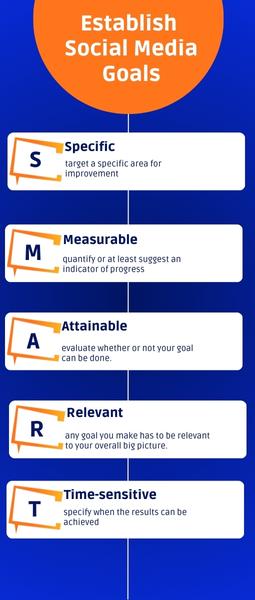
Some social media accounts allow you to create special branded pages in your social media strategy. Some are more adaptable than others. The critical thing to do is to take advantage of whatever functions social media allows. For example, if it allows you to use HTML to create a branded landing page, use the function; if it enables you to upload special photos and images, do so. The more unique your social media accounts are, the better.
When creating branded pages on social media, it's important to realize which social media you're using and read the rules. For instance, your cover image on Facebook cannot ask customers to download anything or give any contact information. Likewise, they do not want any calls to action on your cover photo. Instead, use features such as Facebook's ability to pin a post at the top of the feed so that new viewers will always see that when they arrive. That post can contain a video or simply some text.
The same concepts can be used across all social media. Use the tools available, and maximize your profiles with images, videos, and more that enhance and demonstrate who you are to your audience. Always look at your pages from the audience's perspective to ensure you present your business in the best light possible.
A solid social media strategy will strengthen your business by increasing brand awareness, improving SEO, and advancing customer engagement. In addition, social media marketing is a very cost-effective form of marketing. Your social media marketing strategy goes hand-in-hand with other forms of marketing and is part of good search engine optimization today. Therefore, creating a social media strategy will improve your chances of success.
To set solid social media marketing goals, it's important to understand how to make a goal. Every goal you make must be achievable, specific, and measurable. In addition, creating goals establishes metrics you can study to decide whether or not your efforts are working. Without defined goals, you are just shooting in the dark.
First, your goals should be about the big picture. In this case, your goal is general, such as "I want to get more traffic." or "I want to make more sales." The next step is to break down the big-picture goal into smaller achievable, specific, measurable goals. Since the 1980s, due to George T. Doran using the term in the November issue of Management Review, many people have used the mnemonic device SMART to help them make goals.

Instead of saying, "I want more sales" as your goal, you need to be very specific and write down exactly what you mean by more sales. Such as: "I want to sell more of XYZ products.
You should mention how much you want to sell. For example, instead of "I want to sell more XYZ product," say "I want to sell 20% more XYZ product."
Ensure that you evaluate whether or not your goal can be done. Based on your research, you should know what can happen or not happen. If you've done no market research, making a goal will be hard.
Any goal you make has to be relevant to your overall big picture. For example, if you want to make more sales, but your specific, measurable goal is "Increase traffic by 20 percent." Does that relate? How? Why?
Finally, give yourself a time limit on any goals you want to achieve. Don't leave the time open-ended, or you won't ever reach your goal or an endpoint in which you can evaluate whether you reached your goal or not. So finally, your goal will look like this:
"I want to increase sales of XYZ product by 20 percent by the 4th quarter."
In addition to using this method for establishing your goals, you also want always to evaluate how everything went when the time is over, and then for your next campaign, toss out what did not work and recommit and double down on what did work. This will ensure that each marketing campaign you embark on will be an improvement on the former. Then, as you've likely heard before, rinse and repeat for the best results.
Once you have written down your goals, it's time to identify how you will achieve them. How you reach a goal is called tactics. For instance, you might increase blog posting by 50%, social media interaction by 40%, and double down on-page SEO. All of these tactics will increase the likelihood of your achieving your goals.
Tactics have to support your overall strategy to be effective. To identify tactics, you'll need to:
You create a social media marketing calendar based on your goals and timeline. You'll need a separate calendar for each social media you plan to use for your social media marketing campaign. For example, if you've planned to focus on one or two, that's fine, but create a separate calendar for each.
You can use a tool like Google Calendar to create a separate calendar for each social media account. Still, you can integrate them so that you can see a clear outline of everything needed to be done across all accounts. Plus, it's easy to look at one social media account at a time to see what to do without a cluttered calendar.
Start with due dates. Start with a due date in your calendar and work backward towards today with action items to complete on any given day to work toward your goals. For example, if you've determined to create 20 blog posts about a specific topic a month, you can do it one of two ways. You can arrange to create all 20 blog posts at once by a qualified writer and then schedule them for delivery, or you can do them yourself.
But you'll need to write down the titles, keywords, and subject matter either way so that you can stay on course with your blog posts. Using the Google Calendar to put notes on each date is a handy way to use the technology. You can look at any given day and then do what it says. You'll have all the information at your fingertips.
Identify holidays & special days. While on the calendar, you can easily identify holidays and other special days when you won't be working. This is an excellent way to track your work schedule than just playing it by ear. Plus, you'll be able to ensure that the content you'll deliver near that holiday or other special days is relevant. You can give each holiday a special theme and ensure that your content matches the mood of your audience.
Your marketing calendar is as good as any place to delegate work. For example, if you have a Virtual Assistant or other people who work with you, you can invite them to the calendar and assign them a special color code so they know they are supposed to do that. You can also use a project management system like Basecamp.com to help you manage others on projects by uploading to-do lists and more.
WordPress offers many options that help you make publishing content easy. For instance, you can schedule posts, integrate automatic updates with various social media accounts, and more. Using technology fully will give you more time to devote elsewhere. However, don't automate so much that you forget the most important aspect of social media is the fact that it's social. For instance, automate sharing but still go in and make comments on your own. Automate scheduled posts but check for comments regularly.
A social media marketing calendar will help you control your activities better. Calendars are all part of planning, enabling you to reach your destination. Although you wouldn't travel across the country without a map or GPS, don't try to embark on social media marketing without a plan. A plan will make you more successful, save time, and help guide you.
Like any other marketing campaign, you'll identify your target audience, know where to reach them and develop the message and information you share based on your goals. You'll have more than one campaign based on your goals. Perhaps your goal is to "Increase sales by 20 percent of XYZ product by the end of the 4th quarter."
You'll need to identify the tactics you'll use to increase sales, such as getting more newsletter sign-ups, likes on Facebook and Twitter followers, and perhaps more engagement on Pinterest. Your campaign will consist of getting more sign-ups, likes, or follows, then, in addition, what you'll do with those likes, followers, and sign-ups.
Then you'll create a separate campaign for each part of the goal. For example, based on a statistical analysis of your current sales and resources, you might determine that a way to increase sales by 20 percent is to increase newsletter subscribers by 100 percent. If so, you must create a campaign to increase newsletter subscribers.
You can do this in various ways, from online advertising to an intense content marketing plan using just content and social media. First, identify how you'll do it, then write down the steps in your marketing calendar, creating a separate campaign for each part of a goal.
Read Part Six in our series, Create a Content Repository.